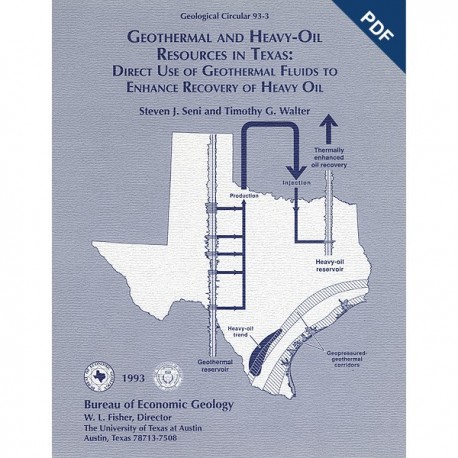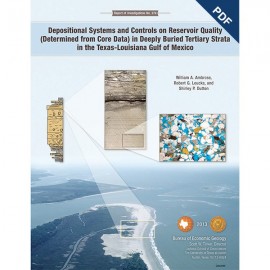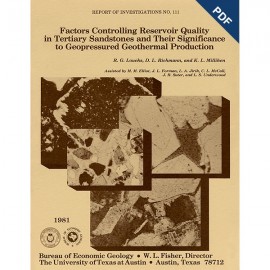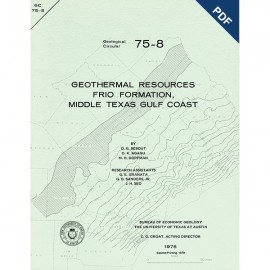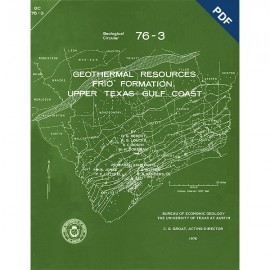Geological Circulars
-
Books & Reports
- Reports of Investigations
- Guidebooks
- Udden Series
- Geological Circulars
- Down To Earth
- Atlases of Major Oil and Gas Reservoirs
- Texas Memorial Museum Publications
- Environmental Geologic Atlas of the Texas Coastal Zone
- Mineral Resource Circulars
- Other Reports
- Seminars and Workshops
- Handbooks
- Submerged Lands of Texas
- Symposia
- Annual Reports
- Open File Reports
-
Maps & Cross Sections
- Thematic Maps
- Miscellaneous Maps, Charts & Sections
- Geologic Atlas of Texas
- STATEMAP Project Maps
- Geologic Quadrangle Maps
- Cross Sections
- Highway Geology Map
- Energy and Mineral Resource Maps
- Shoreline Change and Other Posters
- Wilcox Group, East Texas, Geological / Hydrological Folios
- Bouguer Gravity Atlas of Texas
- River Basin Regional Studies
- Featured Maps
- Posters
- Teachers & the Public
-
Geological Society Publications
- Gulf Coast Association of Geological Societies
- Alabama Geological Society
- Austin Geological Society
- Corpus Christi Geological Society
- Houston Geological Society
- Lafayette Geological Society
- Mississippi Geological Society
- New Orleans Geological Society
- South Texas Geological Society
- GCS SEPM Publications
- Historic BEG & UT Series
Geothermal and Heavy-Oil Resources in Texas...Digital Download
GC9303D
For a print version: GC9303.
GC9303D. Geothermal and Heavy-Oil Resources in Texas: Direct Use of Geothermal Fluids to Enhance Recovery of Heavy Oil, by S. J. Seni and T. G. Walter. 52 p., 34 figs., 6 tables, 4 appendices, 1993. doi.org.10.23867/gc9303D. Downloadable PDF.
To purchase this publication in book format, please order GC9303.
ABSTRACT
In a five-county area of South Texas, geopressured-geothermal reservoirs in the Paleocene-Eocene Wilcox Group lie below medium- to heavy-oil reservoirs in the Eocene Jackson Group. This fortuitous association suggests the use of geothermal fluids for thermally enhanced oil recovery (TEOR). Geothermal fairways are formed, where thick deltaic sandstones are compartmentalized by growth faults. Wilcox geothermal reservoirs in South Texas are present at depths of 11,000 to 15,000 ft (3,350 to 4,570 m) in laterally continuous sandstones 100 to 200 ft (30 to 60 m) thick. Permeability is generally low (typically 1 md), porosity ranges from 12 to 24 percent, and temperature exceeds 250°F (121°C). Reservoirs containing medium (20° to 25° API gravity) to heavy (10° to 20° API gravity) oil are concentrated along the Texas Coastal Plain in the Jackson-Yegua Barrier/Strandplain (Mirando Trend), Cap Rock, and Piercement Salt Dome plays and in the East Texas Basin in Woodbine Fluvial/Deltaic/Strandplain Sandstone and Paluxy Fault Line plays. The Jackson-Yegua Barrier/Strandplain (Mirando Trend) is the most favorable play for TEOR of medium to heavy oil because of the abundance of candidate reservoirs, relative simplicity of reservoir architecture, and shallow depth of burial. Updip pinch-out of shallow barrier bar/strandplain sandstones largely controls the distribution of medium-to heavy-oil reservoirs in the Jackson Group. Subtle structure, small faults, and sandstone-body pinch-outs form lateral barriers of the reservoirs. Structural, depositional, and diagenetic variations cause reservoir compartmentalization. The medium- to heavy-oil reservoirs are typically porous (25 to 35 percent) and permeable (100 to 1,000 md), slightly clayey, fine-to medium-grained sand and sandstones. Calcite-cemented zones of low porosity (approximately 5 percent) and permeability (approximately 0.01 md) compartmentalize the reservoirs.
Injection of hot, moderately fresh to saline brines will improve oil recovery by lowering viscosity and decreasing residual oil saturation. Smectite clay matrix could swell and clog pore throats if injected waters have low salinity. The high temperature of injected fluids will collapse some of the interlayer clays, thus increasing porosity and permeability. Reservoir heterogeneity resulting from facies variation and diagenesis must be considered when siting production and injection wells within the heavy-oil reservoir. The ability of abandoned gas wells to produce sufficient volumes of hot water over the long term will also affect the economics of TEOR.
Keywords: geopressured-geothermal reservoirs, hot-water flood, Jackson Group, Mirando Trend, oil plays, South Texas, thermally enhanced oil recovery, Wilcox Group
Citation
Seni, S. J., and Walter, T. G., 1993, Geothermal and Heavy-Oil Resources in Texas: Direct Use of Geothermal Fluids to Enhance Recovery of Heavy Oil: The University of Texas at Austin, Bureau of Economic Geology, Geological Circular 93-3, 52 p. doi.org.10.23867/gc9303D.
